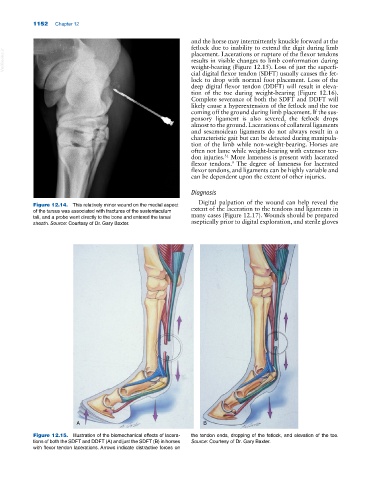Page 1186 - Adams and Stashak's Lameness in Horses, 7th Edition
P. 1186
1152 Chapter 12
and the horse may intermittently knuckle forward at the
fetlock due to inability to extend the digit during limb
VetBooks.ir results in visible changes to limb conformation during
placement. Lacerations or rupture of the flexor tendons
weight‐bearing (Figure 12.15). Loss of just the superfi
cial digital flexor tendon (SDFT) usually causes the fet
lock to drop with normal foot placement. Loss of the
deep digital flexor tendon (DDFT) will result in eleva
tion of the toe during weight‐bearing (Figure 12.16).
Complete severance of both the SDFT and DDFT will
likely cause a hyperextension of the fetlock and the toe
coming off the ground during limb placement. If the sus
pensory ligament is also severed, the fetlock drops
almost to the ground. Lacerations of collateral ligaments
and sesamoidean ligaments do not always result in a
characteristic gait but can be detected during manipula
tion of the limb while non‐weight‐bearing. Horses are
often not lame while weight‐bearing with extensor ten
don injuries. More lameness is present with lacerated
31
flexor tendons. The degree of lameness for lacerated
9
flexor tendons, and ligaments can be highly variable and
can be dependent upon the extent of other injuries.
Diagnosis
Digital palpation of the wound can help reveal the
Figure 12.14. This relatively minor wound on the medial aspect extent of the laceration to the tendons and ligaments in
of the tarsus was associated with fractures of the sustentaculum
tali, and a probe went directly to the bone and entered the tarsal many cases (Figure 12.17). Wounds should be prepared
sheath. Source: Courtesy of Dr. Gary Baxter. aseptically prior to digital exploration, and sterile gloves
A B
Figure 12.15. Illustration of the biomechanical effects of lacera- the tendon ends, dropping of the fetlock, and elevation of the toe.
tions of both the SDFT and DDFT (A) and just the SDFT (B) in horses Source: Courtesy of Dr. Gary Baxter.
with flexor tendon lacerations. Arrows indicate distractive forces on

